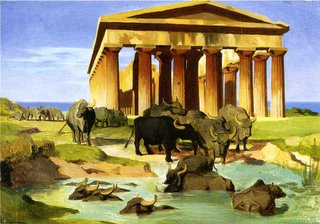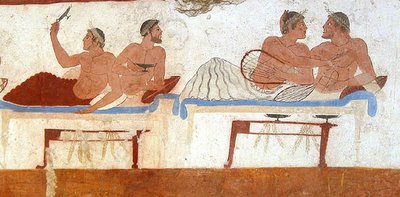A Little Greek Drama

I didn’t see no water buffalo when I visited Paestum…
Paestum is an archaelogical site located south of Naples in the Campania region of Southern Italy. Its magnificent remains are associated with Magna Graecia, which refers to the Greek colonies of southern Italy established in the 8th century B.C.E. The name “Paestum” is the Romanized form of Poseidonia, which is what the original Greek settlers called the town in honor of Poseidon.
Paestum’s Archaic Doric temples were constructed sometime during the late 6th to the early 5th century B.C.E. and survive largely intact. The original stucco covering has long since disappeared exposing the rather porous stone (tuffa rock, I believe) from which the temples were constructed. I think it is safe to say that if Paestum’s archaeological remains were located, like the Parthenon, in the heart of a major metropolitan area, instead of in the middle of Campania’s agricultural plain, they would have suffered major deterioration.
Paestum’s archaeological museum is home to a beautiful series of frescoes taken from the Tomb of the Diver. Interestingly, diver in Italian is tuffatore. I’m not aware of any etymological connection, however, between “tuffatore” and southern Italy’s abundant tuffa rock, which provided the raw materials for Paestum’s temples.
 The frescoes feature several interesting scenes, including a young nude diver. One of the most well known scenes depicts a symposium, a function of aristocratic male social life in ancient Greece (and its colonies). Several male couples recline on a group of couches. On one couch an older, bearded man attempts to kiss a beardless youth. The man places his hand affectionately on the back of the youth’s head, attempting to draw him close, but the youth pushes him away, rejecting his advance. Most scholars agree that an erotic advance is being rejected. However, it is the adjacent couch that interests me more.
The frescoes feature several interesting scenes, including a young nude diver. One of the most well known scenes depicts a symposium, a function of aristocratic male social life in ancient Greece (and its colonies). Several male couples recline on a group of couches. On one couch an older, bearded man attempts to kiss a beardless youth. The man places his hand affectionately on the back of the youth’s head, attempting to draw him close, but the youth pushes him away, rejecting his advance. Most scholars agree that an erotic advance is being rejected. However, it is the adjacent couch that interests me more. 
On that couch, there are two men, one of whom is preparing to fling the remaining drops of wine from his κύλιξ (kylix) onto a special target, as part of a game known as κότταβος (kottabos). Next to him, his drinking partner’s attention has been drawn to the little Greek drama on the next couch and he looks on voyeuristically while the older man’s advances are rejected by his youthful companion. What I find interesting is that the spectator is clearly elbowing his couchmate so that he too can watch the drama unfold. I’ve always thought that perhaps there was some rivalry among the three older men as to which of them would successfully woo the beardless youth.
Another kylix of wine and perhaps they might’ve all had him.
A note on the images:
The top image is Jean-Léon Gérôme’s (1824-1904) View of Paestum (study, 1847, oil on canvas). Below that are the lid and north wall of the Tomb of the Diver (475 B.C.E., Paestum Museum, Paestum).












0 Comments:
Post a Comment
<< Home